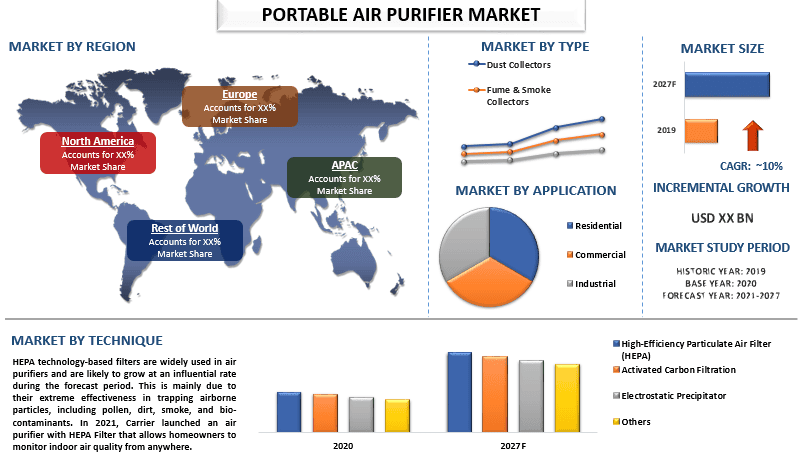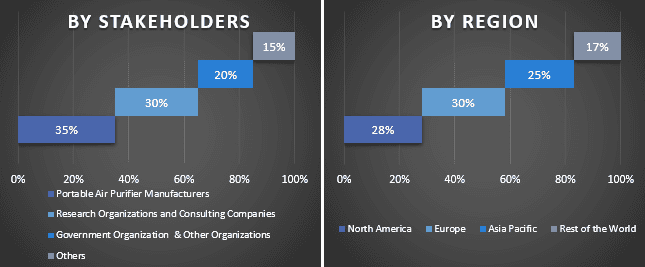Рынок портативных очистителей воздуха: текущий анализ и прогноз (2021-2027)
Акцент на типе (пылеуловители, уловители дыма и газов, прочее); Техника (высокоэффективные воздушные фильтры, активированный уголь, электростатический осадитель и прочее); Применение (жилые, коммерческие и промышленные помещения); Канал дистрибуции (супермаркеты и гипермаркеты, интернет-магазины, магазины у дома, прочее) и регион/страна

Ожидается, что совокупный среднегодовой темп роста (CAGR) мирового рынка портативных очистителей воздуха составит около ~10% в период 2021-2027 гг.Портативный очиститель воздуха является эффективной стратегией для улучшения качества воздуха в помещениях (IAQ) в домах, офисах, ресторанах или других закрытых помещениях. По данным Агентства по охране окружающей среды США (EPA), существует два основных типа технологий, которые используют портативные очистители воздуха для удаления твердых частиц из воздуха. Некоторые портативные очистители воздуха используют воздушные фильтры из волокнистых материалов для улавливания частиц, а некоторые портативные очистители воздуха используют электричество, чтобы заставить частицы в воздухе прилипать к пластинам или другим поверхностям. Кроме того, некоторые портативные очистители воздуха предлагают ультрафиолетовое бактерицидное облучение (UVGI), технологию, которая использует ультрафиолетовый (УФ) свет для повреждения микроорганизмов, таких как бактерии и вирусы, делая их неинфекционными. Одним из самых больших преимуществ портативных очистителей воздуха является простота их настройки, ежедневного использования и обслуживания. Можно легко подключить и использовать очистители воздуха и разместить их в помещениях, нуждающихся в защите. Поэтому эти факторы стимулируют рынок портативных очистителей воздуха. В 2020 году компания Camfil выпустила модель CamCleaner CC500, которая функционирует как портативный очиститель воздуха или канальная система отрицательного давления для создания изоляционных зон.
Honeywell International Inc., IQAir, Koninklijke Philips N.V., Unilever PLC., Samsung Electronics Co., Ltd., LG Electronics Inc., Panasonic Corporation, Whirlpool Corporation, Daikin Industries Ltd., Carrier Global Corporation. Несколько слияний и поглощений (M&A) наряду с партнерствами были предприняты этими игроками, чтобы предоставить клиентам высокотехнологичные и инновационные продукты/технологии.
Сведения, представленные в отчете
«Среди технологий категория высокоэффективных воздушных фильтров (HEPA) занимала значительную долю на рынке в 2020 году»
В зависимости от технологии рынок делится на высокоэффективные воздушные фильтры (HEPA), активированный уголь, электростатические осадители и прочее. В настоящее время фильтры на основе технологии HEPA широко используются в портативных очистителях воздуха и, вероятно, будут расти влиятельными темпами в течение прогнозируемого периода. Это в основном связано с их чрезвычайной эффективностью в улавливании переносимых по воздуху частиц, включая пыльцу, грязь, дым и биологические загрязнители. Высокое качество и надежность фильтров HEPA для удаления переносимых по воздуху частиц, вероятно, увеличат проникновение продукта на мировой рынок.
«Среди областей применения ожидается, что жилой сектор продемонстрирует значительный CAGR в течение прогнозируемого периода»
В зависимости от области применения рынок сегментирован на жилой, коммерческий и промышленный секторы. Жилой сектор занимал значительную долю рынка в 2020 году, что обусловлено строгой и поддерживающей государственной политикой по продвижению «зеленой» экономики и растущей урбанизацией. По данным Агентства по охране окружающей среды США (EPA), воздух в помещении может быть в пять раз более загрязненным, чем наружный воздух. Более 3,8 миллионов человек в год преждевременно умирают от болезней, вызванных загрязнением воздуха в быту, вызванным неэффективным использованием твердого топлива и керосина для приготовления пищи.
«Среди каналов дистрибуции ожидается, что супермаркеты и гипермаркеты продемонстрируют значительный CAGR в течение прогнозируемого периода»
В зависимости от каналов дистрибуции рынок сегментирован на супермаркеты и гипермаркеты, интернет-магазины, магазины у дома и прочее. Сегмент супермаркетов и гипермаркетов доминировал на рынке, и ожидается, что он сохранит свое доминирование в течение всего прогнозируемого периода. Это связано с наличием широкого ассортимента потребительских товаров под одной крышей, достаточным местом для парковки и удобным временем работы.
«Ожидается, что Азиатско-Тихоокеанский регион продемонстрирует значительный рост в течение прогнозируемого периода»
Ожидается, что рынок портативных очистителей воздуха в Азиатско-Тихоокеанском регионе вырастет из-за увеличения загрязнения воздуха в густонаселенном Азиатско-Тихоокеанском регионе. Загрязнение воздуха стало серьезной проблемой с ядовитым воздействием на окружающую среду, здоровье населения и урожайность сельскохозяйственных культур. Однако эти проблемы создают множество возможностей для рынка портативных очистителей воздуха. По данным программы ООН по окружающей среде, 70% смертей, связанных с загрязнением воздуха, приходится на Азиатско-Тихоокеанский регион. Загрязнение воздуха является наиболее острой кризисной ситуацией в мире, связанной с окружающей средой и здоровьем. На его долю приходится более 6,5 миллионов смертей ежегодно. В регионе находятся самые загрязненные города мира из-за растущей индустриализации. В 2019 году общее количество выбросов углекислого газа в Азиатско-Тихоокеанском регионе составило около 17 269,5 миллионов тонн (МТ), что выше, чем в регионе в 2018 году - 16 863,3 МТ. Увеличение выбросов углекислого газа в регионе отражает тот факт, что регион зависит от использования угля, сырой нефти и природного газа для различных целей, при сжигании которых в атмосферу выделяется углекислый газ и другие вредные газы.
Причины для покупки этого отчета:
- Исследование включает в себя определение размера рынка и анализ прогнозирования, подтвержденные аутентифицированными ключевыми экспертами отрасли.
- В отчете представлен краткий обзор общей производительности отрасли с первого взгляда.
- Отчет содержит углубленный анализ видных представителей отрасли с основным упором на ключевые финансовые показатели бизнеса, продуктовые портфели, стратегии расширения и последние разработки.
- Детальное изучение факторов, ограничений, ключевых тенденций и возможностей, преобладающих в отрасли.
- Исследование всесторонне охватывает рынок по различным сегментам.
- Углубленный анализ отрасли на региональном уровне.
Варианты настройки:
Мировой рынок портативных очистителей воздуха может быть дополнительно настроен в соответствии с требованиями или любым другим сегментом рынка. Кроме того, UMI понимает, что у вас могут быть свои собственные бизнес-потребности, поэтому не стесняйтесь связаться с нами, чтобы получить отчет, который полностью соответствует вашим требованиям.
Содержание
Методология исследования для анализа мирового рынка портативных очистителей воздуха (2021-2027 гг.)
Анализ исторического рынка, оценка текущего рынка и прогнозирование будущего рынка мирового рынка портативных очистителей воздуха были тремя основными шагами, предпринятыми для создания и анализа внедрения портативных очистителей воздуха в основных регионах мира. Для сбора исторических данных о рынке и оценки текущего размера рынка были проведены исчерпывающие вторичные исследования. Во-вторых, для проверки этих данных были приняты во внимание многочисленные выводы и предположения. Кроме того, были проведены исчерпывающие первичные интервью с экспертами отрасли по всей цепочке создания стоимости мирового рынка портативных очистителей воздуха. После предположения и проверки данных рынка посредством первичных интервью мы применили восходящий/нисходящий подход к прогнозированию полного размера рынка. После этого были приняты методы разбивки рынка и триангуляции данных для оценки и анализа размера рынка сегментов и подсегментов соответствующей отрасли. Подробная методология объясняется ниже:
Анализ исторического размера рынка
Шаг 1: Углубленное изучение вторичных источников:
Детальное вторичное исследование было проведено для получения исторического размера рынка портативных очистителей воздуха с помощью внутренних источников компании, таких какгодовые отчеты и финансовые отчеты, презентации о результатах деятельности, пресс-релизы и т. д.и внешние источники, включаяжурналы, новости и статьи, правительственные публикации, публикации конкурентов, отраслевые отчеты, сторонние базы данных и другие заслуживающие доверия публикации.
Шаг 2: Сегментация рынка:
После получения исторического размера рынка портативных очистителей воздуха мы провели детальный вторичный анализ для сбора исторических данных о рынке и доли различных сегментов и подсегментов для основных регионов. Основные сегменты включены в отчет по типу, технике, применению, каналу дистрибуции и региону. Далее были проведены анализы на уровне стран для оценки общего внедрения моделей тестирования в этом регионе.
Шаг 3: Факторный анализ:
После получения исторического размера рынка различных сегментов и подсегментов мы провели подробныйфакторный анализдля оценки текущего размера рынка портативных очистителей воздуха. Далее мы провели факторный анализ, используя зависимые и независимые переменные, такие как рост спроса на средства для ухода за воздухом и повышение обеспокоенности качеством воздуха в помещениях. Был проведен тщательный анализ сценариев спроса и предложения с учетом ведущих партнерств, слияний и поглощений, расширения бизнеса и запуска продуктов в секторе рынка портативных очистителей воздуха по всему миру.
Оценка и прогноз текущего размера рынка
Определение текущего размера рынка:Основываясь на практических выводах, полученных в ходе вышеуказанных 3 шагов, мы пришли к текущему размеру рынка, ключевым игрокам на мировом рынке портативных очистителей воздуха и рыночным долям сегментов. Все требуемые доли в процентах, разделения и разбивки рынка были определены с использованием вышеупомянутого вторичного подхода и были проверены посредством первичных интервью.
Оценка и прогнозирование:Для оценки и прогнозирования рынка веса были присвоены различным факторам, включая драйверы и тенденции, ограничения и возможности, доступные для заинтересованных сторон. После анализа этих факторов были применены соответствующие методы прогнозирования, т. е. восходящий/нисходящий подход, для получения прогноза рынка на 2027 год для различных сегментов и подсегментов на основных рынках мира. Методология исследования, принятая для оценки размера рынка, включает в себя:
- Размер рынка отрасли с точки зрения выручки (USD) и темпы внедрения рынка портативных очистителей воздуха на основных рынках внутри страны
- Все доли в процентах, разделения и разбивки сегментов и подсегментов рынка
- Ключевые игроки на мировом рынке портативных очистителей воздуха с точки зрения предлагаемых решений. Также стратегии роста, принятые этими игроками для конкуренции на быстрорастущем рынке
Проверка размера и доли рынка
Первичные исследования:Углубленные интервью были проведены с ключевыми лидерами общественного мнения (KOL), включая руководителей высшего звена (CXO/VP, руководитель отдела продаж, руководитель отдела маркетинга, руководитель отдела эксплуатации, региональный руководитель, руководитель страны и т. д.) в основных регионах. Затем результаты первичных исследований были обобщены, и был проведен статистический анализ для подтверждения заявленной гипотезы. Данные, полученные в результате первичных исследований, были консолидированы со вторичными выводами, превращая, таким образом, информацию в практические идеи.
Разделение основных участников по различным регионам

Инженерия рынка
Для завершения общей оценки рынка и получения точных статистических данных по каждому сегменту и подсегменту мирового рынка портативных очистителей воздуха использовалась техника триангуляции данных. Данные были разделены на несколько сегментов и подсегментов после изучения различных параметров и тенденций в областях типа, техники, применения, канала сбыта и региона на мировом рынке портативных очистителей воздуха.
Основная цель исследования мирового рынка портативных очистителей воздуха
В исследовании были определены текущие и будущие рыночные тенденции мирового рынка портативных очистителей воздуха. Инвесторы могут получить стратегическое понимание для обоснования своих решений об инвестициях на основе качественного и количественного анализа, проведенного в исследовании. Текущие и будущие рыночные тенденции определили общую привлекательность рынка на региональном уровне, предоставив платформу для участников отрасли, чтобы использовать неиспользованный рынок для получения преимущества первопроходца. Другие количественные цели исследований включают:
- Проанализировать текущий и прогнозируемый размер рынка портативных очистителей воздуха в стоимостном выражении (USD). Также проанализировать текущий и прогнозируемый размер рынка различных сегментов и подсегментов
- Сегменты исследования включают области типа, техники, применения, канала сбыта и региона.
- Определение и анализ нормативной базы для отрасли рынка портативных очистителей воздуха.
- Анализ цепочки создания стоимости с присутствием различных посредников, а также анализ поведения клиентов и конкурентов в отрасли.
- Проанализировать текущий и прогнозируемый размер рынка портативных очистителей воздуха для основного региона.
- Основные страны регионов, изученные в отчете, включают Северную Америку, Европу, Азиатско-Тихоокеанский регион и остальной мир.
- Профили компаний на рынке портативных очистителей воздуха и стратегии роста, принятые игроками рынка для удержания позиций на быстрорастущем рынке
- Углубленный анализ отрасли на региональном уровне
Связанные Отчеты
Клиенты, купившие этот товар, также купили










